13 proven donor acquisition strategies for nonprofits

Acquiring passionate new donors is important for nonprofit organizations, both to fill the gaps left by lapsed donors and to ensure your support network grows over time. But finding new donors with the potential to be valuable, long-term supporters of your cause can be challenging. You need a holistic donor acquisition plan that uses a variety of effective strategies for attracting and securing interested donor prospects.
In this guide, we’ll cover the basics of acquiring donors with donor management software and explore 13 proven strategies for doing so.
What is donor acquisition?
Donor acquisition is the multi-stage process of finding and converting prospective donors to support your nonprofit. Through donor acquisition, nonprofits, not-for-profits, and other organizations turn interested individuals into dedicated financial supporters of their causes.
Donor acquisition’s place in the fundraising cycle
Acquisition plays a major role in the overall fundraising and donor cultivation cycle. In the cultivation cycle, four different stages work together to make up the donor acquisition process:
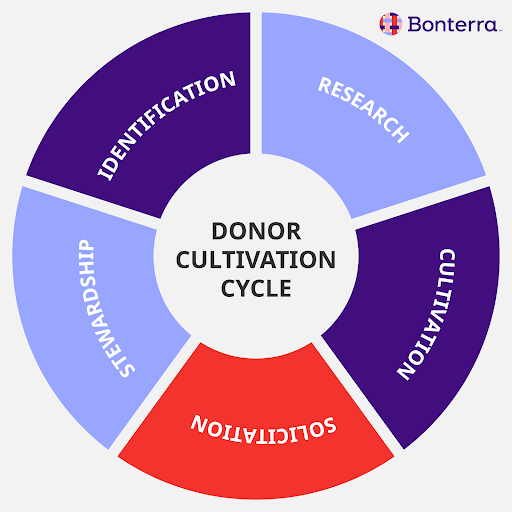
- Identification: Before you can acquire new donors, you need to identify your target audience. In major gift fundraising, this means identifying individual prospects to cultivate, but you only need to determine a broad target audience for general donor acquisition.
- Research: Researching prospective donors may involve diving into specific individuals’ giving habits or exploring the interests and demographics of your target audience more generally. Use research to understand potential donors’ motivations and craft marketing content that speaks to them.
- Cultivation: During the cultivation stage, you’ll work to introduce donors to your cause and build initial relationships that inspire them to give. This stage is vital and often time-intensive for major donor fundraising, but it may be accomplished just by sharing information about your work with smaller prospective donors.
- Solicitation: The solicitation stage is when you finally make your fundraising ask and secure a donation from a prospect, officially turning them into a new donor.
The final stage of the cycle, stewardship, includes all of the efforts you take to retain the donors you’ve acquired.
Although donor retention is easier and more cost-effective than finding brand-new donors to welcome into the fold, donor acquisition is still important, especially for newer nonprofits that don’t have many donors yet. Aim for a balance between donor acquisition and retention unless your nonprofit currently needs to prioritize one or the other.
Calculating donor acquisition KPIs
To create and maintain a successful donor acquisition strategy, it’s important to set goals and continually monitor your progress. Most nonprofits do this by tracking a few key performance indicators (KPIs) that tell them about the efficacy and cost-effectiveness of their donor acquisition efforts.
A few common donor acquisition KPIs include:
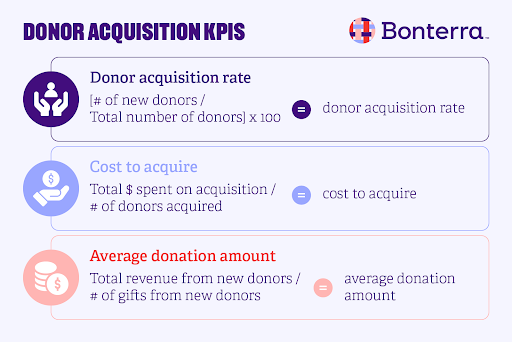
- Donor acquisition rate: This metric tells you how much of your current donor base is made up of newly acquired donors. Select a time period, then use this formula to calculate your donor acquisition rate: [# of new donors / Total number of donors] x 100 = donor acquisition rate
- Cost to acquire: Also known as your donor acquisition cost, this metric represents how much your nonprofit spends to acquire a single donor. After running a donor acquisition campaign, note your spending and calculate: Total amount spent on acquisition / # of donors acquired = cost to acquire
- Average donation amount: Donor acquisition isn’t just about the number of donors you receive — it’s also crucial to measure how valuable new donations are by calculating your average donation amount. To do so, use this formula: Total revenue from new donors / # of gifts from new donors = average donation amount
By looking at all of these metrics together, you can get insight into how well your donor acquisition strategies are working, if you’re bringing in enough fundraising revenue to justify the costs, and what your ultimate return on investment (ROI) is. If you see a low ROI or find that you’re only bringing in minor donors, try out different strategies aimed at securing donors who can give larger gifts.
13 proven strategies for getting new donors
Now that you know the basics, explore the top donor acquisition strategies and choose several that align with your nonprofit’s budget and goals. Ideally, you should use many different tactics to cast a wide net and discover which ones work best for your audience over time.
1. Use robust fundraising software.
The software your nonprofit uses impacts every aspect of your operations, from project management to event planning to new donor acquisition. Before you try out any other acquisition strategies, ensure that you have a solid foundation by using the right tools.
Specifically, your donor database and fundraising toolkit should include the following key features to help you boost donor acquisition:
- Supporter profiles where you can record details about each prospective donor’s contact information, charitable interests, and communication preferences
- Marketing automation that enables you to easily create personalized email appeals and track prospects’ engagement with them
- Peer-to-peer fundraising technology so your existing donors can help you acquire new donors by fundraising on your behalf and sharing your cause with friends and family
- Custom reporting dashboards that help you track donor acquisition KPIs and monitor your campaigns’ progress at a glance
Remember that new donor prospects might already be familiar with your organization. Some of the most promising prospects often come from your existing support base, whether they’re frequent volunteers or individuals who are in your database because they signed a petition. Having a robust, intuitive donor database is key for identifying and converting these potential donors.
2. Tap into your current support base.
Make an intentional effort to find new donors within your support base and the networks of existing donors. Include volunteers in your nonprofit’s fundraising appeals to convert them into donors, and empower loyal supporters to reach out to their peers about your cause.
The connections that your closest supporters have with their family members, friends, and colleagues can be a powerful avenue for getting new donors. For instance, a board member’s nephew might be passionate about your cause and have substantial means to give. Or, the employer of a few of your volunteers might be looking for a nonprofit to support as part of their CSR program.
Consider the people who are the most dedicated to your purpose and may have extensive networks you can connect with, such as:
- Board members
- Major donors
- Long-time recurring donors
- Staff members
- Frequent volunteers
Ask these dedicated supporters to network on your behalf, whether through a peer-to-peer fundraising campaign or just by discussing your nonprofit’s work with them. Remember to thank these supporters for any new donors they bring to your organization to strengthen these existing relationships, too.
3. Use prospect research to identify potential major donors.
While all prospects are important to your organization’s purpose, major donor prospects warrant extra time and attention due to how large their potential donations could be. This is why it’s crucial to include dedicated strategies for identifying major donors within your donor acquisition plan and to utilize prospect research tools.
The best way to do so is through prospect research, the process of searching your donor database and external sources for markers that indicate a prospect could be interested in giving a major gift.
Start by looking through your existing pool of supporters for the following markers:
- Financial capacity: Look for prospects with lucrative careers, business affiliations, real estate holdings, and other indicators of wealth. Use Google searches and explore other nonprofits’ websites to see if they have significant giving histories at other organizations, too.
- Affinity for your cause: Major donor prospects should have experiences and values that indicate a passion for your cause. Look for past involvement, political contributions, and charitable interests that align with your work.
- Philanthropic interest: Make sure that every prospect has a history of involvement with philanthropic causes. Explore donor lists in other organizations’ annual reports, artistic playbills, and fundraising event programs to discover interested prospects.
Keep in mind that every major donor prospect should have some kind of existing connection to your nonprofit. They may be acquainted with one of your board members, or they may have attended a joint fundraising event you hosted with another nonprofit. Your best chances of major donor acquisition lie with those you already have an established connection with.
4. Solidify your nonprofit’s branding.
Your nonprofit’s brand may not be the first thing you think of when you consider donor acquisition, but it’s an important part of an effective long-term strategy.
Essentially, your brand determines how prospective and current donors perceive and relate to your purpose. If your branding is engaging, memorable, and clearly cause-relevant, prospects will be more likely to learn more about your cause and eventually donate. To make sure your branding is helpful for donor acquisition, evaluate your nonprofit’s:
- Name, tagline, and purpose statement
- Visual brand, including your logo, fonts, and colors
- Voice and tone
Each of these elements should work together to create a strong, cohesive brand that stands out and leaves a positive impression on donor prospects. Decide if you need to improve any of your branding elements, then update the branding across your website, outreach emails, direct mail, social media, and any other communication channels you use for getting new donors.
5. Optimize your website for donor acquisition.
Once your branding is solidified, look at your website and make any necessary changes to optimize it for donor acquisition.
Your nonprofit’s website is often the first place prospective donors will go to learn more about your cause or make the decision to donate, so take the following steps to increase its appeal to new donors:
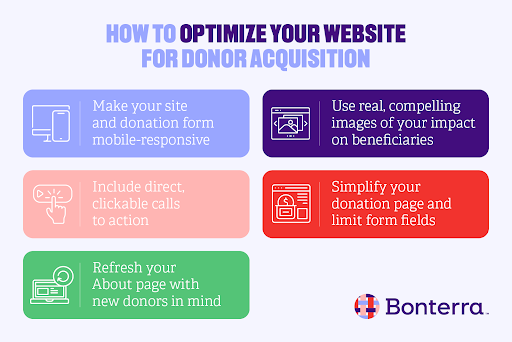
- Make your site and donation form mobile-responsive: Over 60% of web traffic comes from mobile users, so it’s crucial to make your website accessible and user-friendly for supporters using smartphones or tablets. All website elements should be sized properly using responsive design, which makes your website fit and function on any device size. Pay special attention to your donation page to make sure mobile users can give easily.
- Use real, compelling images of your impact on beneficiaries: The right photos can communicate the important work you do quickly and show prospective donors what their contributions can accomplish. Feature your beneficiaries if possible, but make sure to get their permission first using a photo policy or release form.
- Include direct, clickable calls to action (CTAs): Lead users toward donating using CTA buttons that are impossible to miss. Create simple, clickable CTAs that encourage donors to learn more and give. Include them in your website’s navigation bar, homepage, About page, and any other places prospective donors are likely to visit.
- Simplify your donation page and limit form fields: For online donation forms, less is more. Ask for a minimal amount of information from new donors to make the giving process as fast and easy as possible. Limit fields to necessary information like the donor’s first and last name, payment information, and email address.
- Refresh your About page with new donors in mind: Interested prospects may go straight to your About page to learn more about your nonprofit’s cause, purpose, and history. Update this page to ensure it addresses any questions or concerns prospective donors might have about your organization.
After making these changes, run your optimized website by a few of your current supporters and prospects to see what they think. Take any feedback into consideration to make your website as appealing to new donors as possible.
6. Leverage multichannel communications.
Combining both traditional and digital communication channels provides multiple touchpoints for interaction and increases your chances of reaching as many prospects as possible. Adopt a multichannel communications strategy to acquire donors through:
- Word-of-mouth marketing
- Direct mail
- Email campaigns
- Social media
- Blog posts on your website
- Video marketing
For the best results, meet your prospective donors where they are. Find out what social media platforms they use, where they get their news, and what other organizations they support. Then, focus your donor acquisition strategy on these channels and others that are popular with your target demographics.
Be sure to maintain positive, donor-centric language across channels to show how important and impactful donors are to your cause. For instance, when asking a prospective donor to come to your next walk-a-thon event, you might use copy like, “With each step, you can make a difference to youth in need.”
7. Be transparent about donors’ impact.
Donors want to know that their hard-earned money is going towards a worthy and significant cause. Show new donors that giving to your organization is a worthwhile act by explicitly stating what a donation will be put toward. This helps prospective donors visualize the change they could make and gives them a better understanding of how your nonprofit drives impact.
One of the best places to include transparent impact details is on your donation page itself. To see this donor acquisition strategy in action, take a look at the suggested donation amounts on UK nonprofit Save the Children’s website:
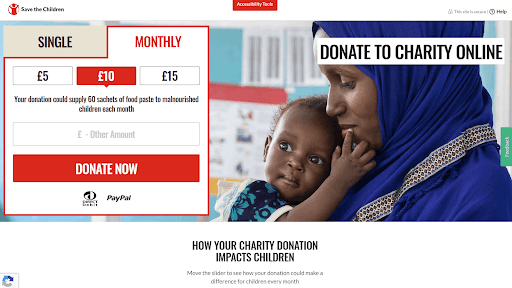
This organization stresses the importance of even small donations and emphasizes how much more of an impact donors can make with recurring giving.
Go beyond required legal transparency by demonstrating both financial and ethical transparency for new donors. Incorporate true stories and impact numbers into your marketing materials, and make your annual returns accessible through your website to help reassure new donors that you’re a trustworthy organization.
8. Create donation tiers.
Donation tiers with set values can help first-time donors gauge what the typical amount to donate is and encourage them to give more than they might on their own.
These donation tiers can take the form of suggested giving amounts as we discussed above, or you can go further by listing designated tiers on your website with creative names like “The Top Givers’ Club.” Tiers may act as donor membership levels with special perks, or they can just be used to inspire more donations.
Either way, tie the names for your donation tiers to your nonprofit’s purpose. For instance, if you’re an animal shelter, you could offer tiers such as “Pawsitive Partner” or the “Four-Legged Founders Club.”
9. Highlight recurring giving.
Recurring or monthly donations are some of the best contributions your organization could ask for, as they help you earn more from individual donors over time while making it easier for them to give. Recurring donations are clearly effective for donor retention, but they can also help you draw in new donors.
How does recurring giving work as a donor acquisition strategy? By giving new donors the option to give smaller amounts on a regular basis, you can provide them with an easy way to start giving to your organization that doesn’t take much out of their budgets.
To inspire recurring gives and increase donor acquisition in the process, start by adding a convenient recurring gift option to your donation page. Set recurring giving as the go-to option, or add a checkbox to your donation form that supporters can check to easily turn their donation into a monthly gift. Then, highlight recurring giving in your marketing materials across channels and emphasize the benefits for new and existing donors.
10. Host a Giving Day.
Similar to GivingTuesday but on a smaller, more individualized scale, Giving Days are concentrated fundraising efforts to raise a certain amount of funds in one day.
Since Giving Days are virtual and fast-paced, they work well for boosting donor acquisition and expanding your reach beyond the local area. This is an ideal opportunity for gathering contact information, encouraging engagement, and getting feedback on your work in addition to getting new donors.
You can host a Giving Day by taking the following simple steps:
- Choose a date far enough in advance that you have time for both planning and marketing.
- Set a fundraising goal.
- Use a Giving Day platform to design a profile or microsite where existing and new donors can give.
- Start promoting your Giving Day on social media, your website, and beyond.
Additionally, make a plan for how to engage with new donors after your Giving Day ends. Use personalized emails, direct mail, or even text messages to start building relationships and soliciting further support after the event ends.
Download our free guide to Giving Day success.
11. Make the most of peak giving times.
While many donors give at different times of the year due to personal preferences and budget availability, there are specific times when individuals are more likely to be in the giving spirit.
For instance, as the year draws to a close, most people have a firmer grasp of their financial situations and know how much money they can reasonably set aside to donate to charity. As a result, GivingTuesday and the holiday season are great opportunities to broadcast your organization’s purpose to potential donors who enjoy taking part in the dedicated season of giving.
In addition to the year-end giving season, analyze the donation data in your CRM to identify other trends and peak giving times that are unique to your organization. Lean into these donor acquisition opportunities by increasing your marketing activity around those times or hosting special campaigns or events aimed at getting new donors.
12. Maximize corporate partnerships.
Many corporations seek to develop their culture of philanthropy through nonprofit partnerships. These corporate partnerships can offer a substantial amount of financial support to your nonprofit in the form of programs like:
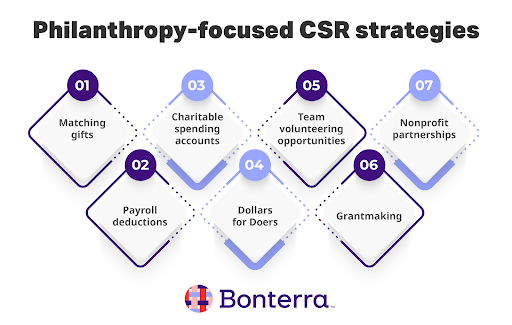
- Matching gift programs
- Employee payroll deductions
- Charitable spending accounts
- Dollars for Doers grants
- Team volunteering opportunities
- Grantmaking programs
- Nonprofit partnerships and sponsorships
Any of these corporate giving activities can provide valuable donor acquisition opportunities. Whether you co-host an event with a local business or receive a corporate foundation grant, you should work diligently to identify potential donors within the companies you partner with. To do so, promote volunteer opportunities, encourage donations, and invite participating employees to upcoming events.
13. Get your board involved in donor acquisition.
Finally, don’t be afraid to ask your board members to help with fundraising and donor acquisition. Invite deeper engagement from your board by sharing more ways for them to get involved in your purpose.
These might include helping with major donor cultivation, fundraising event planning efforts, or introductions to new donor prospects. Urge them to discuss your nonprofit’s impact in conversations with friends and colleagues and take the initiative to get involved with any donor acquisition efforts they have an interest in.
After asking board members to take action, keep them informed with frequent updates and consistent communication to ensure they have everything they need to advocate for your organization.
Putting your donor acquisition strategies into practice
As you try out these donor acquisition strategies and start getting new donors, consider how you can keep them around for the long haul. Employ stewardship techniques, such as sending personalized communications, throwing donor appreciation events, and soliciting donor feedback through surveys to inspire meaningful support for years to come.
Using the right donor management software can make a big difference in your donor acquisition success as you put these strategies into practice. Make sure your platform suits your needs, and explore other software options like Bonterra Fundraising + Engagement if your current database needs an upgrade.
Acquire more donors with the top donor management software.
Work with Bonterra



